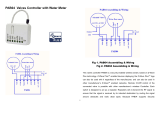
- 2 -
Group 1: Association with 5 Controller nodes.
Group 2: Association with 5 nodes.
Group 1 commands:
When the unit is powered up for first time, a Notification Report will be sent to the node of Group 1.
When performing Factory Reset, a Device Reset Locally Notification will be sent to the node of Group 1.
When the device is on or off, the unit will send a Binary Switch Report to the node of Group 1.
Group 2 commands:
When button is pressed, a BASIC SET command containing a value will be sent to the node of Group 2
(When the device is off, Basic Set Value=0x00, when the device is on, Basic Set Value=0xFF).
Z-Wave Plus Info (Root/Endpoint1/Endpoint2)
Version
3 (Slave_Enhance_232_Library)
Manufacturer
AGI (Association Group Information) Table
Command Class & Command (List) N bytes
Binary Switch Report,
Notification Report,
Device Reset Locally Notification
Basic commands
Inquire about the status of the device
Report the status of the device.
Set the status of the device.(Value=0XFF (ON), 0x00 (OFF))
Notification
Power applied for first time
Configuration
The configurable values are as following:
Set whether to remember the
last status
1: remember
(0: do not remember)
Command Classes
The module supports Command Classes including…
COMMAND_CLASS_ZWAVEPLUS_INFO_V2
COMMAND_CLASS_ASSOCIATION_V2
COMMAND_CLASS_ASSOCIATION_GRP_INFO
COMMAND_CLASS_MULTI_CHANNEL_ASSOCIATION_V2
COMMAND_CLASS_TRANSPORT_SERVICE_V2
COMMAND_CLASS_VERSION_V2
COMMAND_CLASS_MANUFACTURER_SPECIFIC_V2
COMMAND_CLASS_DEVICE_RESET_LOCALLY
COMMAND_CLASS_POWERLEVEL
COMMAND_CLASS_SECURITY
COMMAND_CLASS_SECURITY_2
COMMAND_CLASS_SUPERVISION
COMMAND_CLASS_FIRMWARE_UPDATE_MD_V4
COMMAND_CLASS_NOTIFICATION_V8
COMMAND_CLASS_CONFIGURATION
COMMAND_CLASS_SWITCH_BINARY
Additional Command Classes Supported
Binary Switch: Refer to Basic.
Multi Channel: To control 2 relay independently.
Firmware Update: For OTA function.
Troubleshooting
The table below lists the several steps involved when adding or removing the detector from the Z-Wave
network.
The Z-Wave Controller does not allocate a node ID to the
unit.
2-second on,
2-second off
1. Put the Z-Wave Controller into inclusion mode.
2. Press the link key three times within 1.5 seconds to
put the unit into inclusion mode.
1. Put the Z-Wave Controller into exclusion mode.
2. Press the link key three times within 1.5 seconds to
put the unit into exclusion mode.
Reset
(This procedure
should only be used
when the network
primary controller is
inoperable.)
1. Press the link key three times within 1.5 seconds to
put the unit into exclusion mode.
2. Within 1 second of step 1, press link key again and
hold until LED is off (about 5 seconds).
3. Node ID is excluded. The device reverts to factory
default state and will be in auto-inclusion mode for 4
minutes.
Failed or successful results in including/excluding the ID can be viewed on the Z-Wave Controller.
Note: If you are connecting this unit to a Z-Wave Controller that utilizes the S2 security protocol, you may be
asked to enter a 5 digit Device Specific Key (DSK) that is unique to each unit by your controller. This can be
found in one of two places:
- on the QR code label on the back of the unit
- on the insert card inside the packaging
Table below lists typical problems encountered:
Device not responding and
LED not displaying
The device is not wired to the
mains power correctly
Check if wiring is correct, or
voltage is too high or too low
Send the device to be repaired
LED displaying, but cannot
control On/Off status of
connected load
The connected load has its own
on/off switch
Turn the switch of the
connected load to On.
Cannot control by RF but
switch control works.
RF interference is occurring.
Someone nearby might be
emitting RF signal of the same
Wait for a while and retry the
operation








